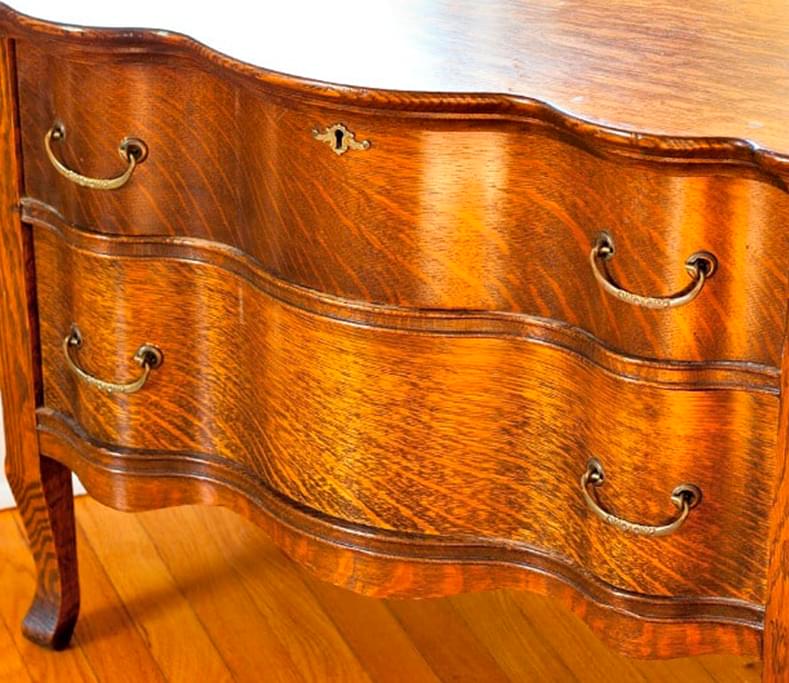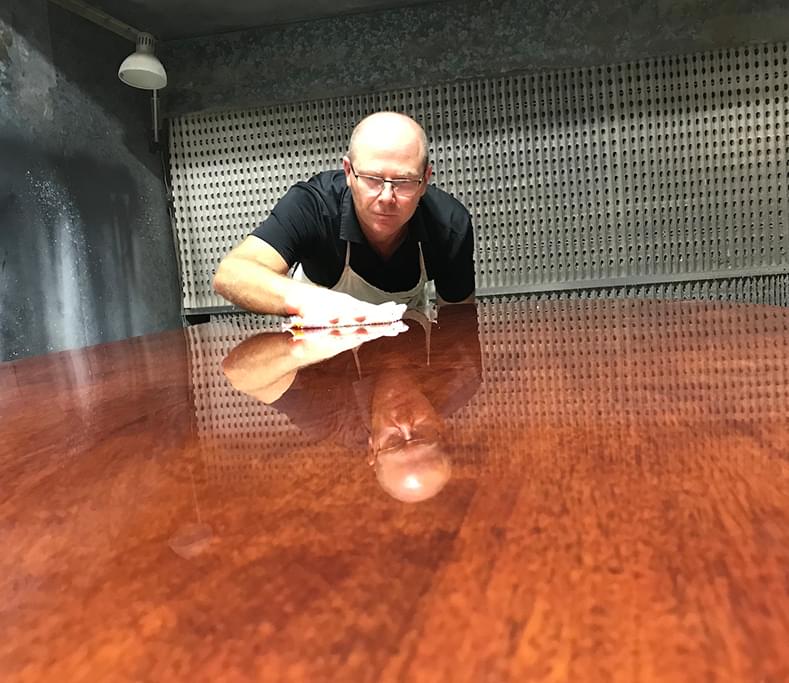About Us

ABOUT CHRISTOPHER ESCRIVA
Christopher with his family emigrated from France in 1969. Arriving in Fremantle W.A. They then moved to Bonegilla migrant camp in Victoria and finally settled in Adelaide South Australia. Christopher’s father being a carpenter and a fourth generation woodworker it was only natural that Christopher would follow in those footsteps. Learning the trade from the age of fourteen Christopher found his natural flair to be in french polishing.
Specialising in antique wooden furniture restoration Christopher continued his training with a leading antique wooden furniture restorer in Adelaide. Eventually moving to Sydney for work in a major eastern suburbs company in the 1990s Christopher spent a number of years travelling to Sydney to work for this company. Christopher has now settled in Sydney to provide a unique service to the community. This service allows for your antique wooden furniture to be french polished in your home. Potentially saving a customer thousands of dollars, a number of factors make this service unequalled: Lower overheads means lower costs. Costs savings of transporting furniture. Minimising risk of damage or loss of prized furniture. Christopher ensures his clients are completely satisfied using only the best quality protection available to carry out the work required in your home. Any furniture that requires substantial restoration or handstripping must be taken away to be restored. In a few words this service is unsurpassable value.

List of furniture types restored by Christopher:
- Writing boxes
- Jewellery boxes
- Cutlery boxes
- Trunks
- Chests
- Nests of tables
- Drop side tables
- Dining tables
- Extension tables
- Hall tables
- Occasional tables
- Dressing tables
- Coffee tables
- Bedside tables
- Bentwood chairs
- Balloon back chairs
- Splade back chairs
- Spindle back chairs
- Ladder back chairs
- Morris chairs
- Rocking chairs
- Grandfather chairs
- Grandmother chairs
- High chairs
- Chests of Drawers
- Tallboys
- Ice Chests
- Sideboards
- Chiffioniers
- Wardrobes
- Armoires
- Beds
- Washstands
- Bedside Cabinets
- Mirrors
- Shelves
- Bookcases
- Church Pews
- Benches
- Desks
- Drop Front Desks
- Roll Top Desks
- Pedestal Desks
- China Cabinets
- Filing Cabinets
- Kitchen Cabinets
- Meat safes
- Hallstands
- Fireplace Surrounds
- Screens
- Tray mobiles

ABOUT CHRISTOPHER ESCRIVA
Is it ok to use a damp cloth to dust my furniture?
 No. The damp cloth may be great to pick up dust but the moisture will slowly deteriorate your polished surface. I recall seeing a victorian mahogany extension table with an original finish 90% worn due to dusting with a damp cloth, as it is a very slow process my client didn’t realize the moisture was breaking down the polish.
No. The damp cloth may be great to pick up dust but the moisture will slowly deteriorate your polished surface. I recall seeing a victorian mahogany extension table with an original finish 90% worn due to dusting with a damp cloth, as it is a very slow process my client didn’t realize the moisture was breaking down the polish.
If a damp cloth is not suitable for daily or weekly cleaning, what is?
I recommend for daily or weekly use a product called Marveer, its a silicone free spray wax. Its safe and easy to use not requiring the labour of a beeswax. Available from any Woolworths store and priced around $4.50 a can I’ve found it to be the best available product of its type.
Can I use oils to polish my furniture?
 No. The damp cloth may be great to pick up dust but the moisture will slowly deteriorate your polished surface. I recall seeing a victorian mahogany extension table with an original finish 90% worn due to dusting with a damp cloth, as it is a very slow process my client didn’t realize the moisture was breaking down the polish.
No. The damp cloth may be great to pick up dust but the moisture will slowly deteriorate your polished surface. I recall seeing a victorian mahogany extension table with an original finish 90% worn due to dusting with a damp cloth, as it is a very slow process my client didn’t realize the moisture was breaking down the polish.
How often should I wax my furniture?
I recommend every three to six months using a soft paste beeswax. It provides protection for your polished surfaces from scratches and liquids. For those who find waxing too arduos the Marveer product from Woolworths is ideal. The beeswax I recommend is the Bio wax produced in Adelaide and only sold in Sydney at ECO at HOME in Willoughby. Visit their website ECO at HOME to view or purchase this product.
I have an old pine kitchen dresser and I want a wax finish, is that recommended?
 I do not recommend waxing straight on timber but do suggest oiling your kitchen dresser. Over time an oil finish will give much better protection and a better result. Waxing would certainly be an option once you have oiled your dresser with four or five applications of oil.
I do not recommend waxing straight on timber but do suggest oiling your kitchen dresser. Over time an oil finish will give much better protection and a better result. Waxing would certainly be an option once you have oiled your dresser with four or five applications of oil.
ABOUT NATIVE AUSTRALIAN TIMBER

Birdeye Huon Pine

Birdeye Huon Pine

Birdeye Huon Pine

Birdeye Huon Pine

Birdeye Huon Pine

Birdeye Huon Pine
Australia can consider itself very fortunate for its diversity and it is not more evident than in its ecology. From the Maple and Kauri Pine forests of Queensland, the Cedar forests of New South Wales and Queensland, the Jarrah forests of Western Australia and the Blackwood or Huon Pine forests of Tasmania. These are but a few of the timbers used in the history of early Australian furniture making.
The early settlers searched for timber that would be durable and strong to use for ships, bulding and of course furniture. The discovery of the tall Cedar trees in the Hawkesbury and Hunter river areas became a very important commodity for comercial export. The history of the early settlers and their relationship with the Cedar tree is too long to go into detail here, but it is a fact by the 1870’s the Cedar tree had become scarce in New South Wales. Unlike a lot of timbers Cedar ages beautifully enhancing the look of a piece of furniture not more evident than in an early 19th century item.
I have personally restored so many Cedar pieces of furniture its impossible to put a number on it. One of my favorites being the D.end extension table seen on my website. My next favorite timbers are Huon Pine and Blackwood both native from Tasmania. Huon Pine trees grow in the West and South West regions of Tasmania. Prized by the early boat builders for its qualities Huon Pine contains quantities of a natural preserving oil not evident in other timbers which make it easy to work with, water resistant and insect resistant.
These qualities made it the most sought after timber by boat builders. The early furniture makers of Australia were very fortunate to have access to some exceptionally grained timber. View my website for some stunning examples. Modern furniture made with Huon Pine is distinctly more yellow in colour but as it’s exposed to sunlight with time it naturally gets richer in colour.
Huon Pine antique furniture is certainly more prominent in Adelaide and Melbourne and certainly almost non-existent in Tasmania. It was in the 1970’s through to the 1990’s that mainland Australia sought out nearly all the Huon Pine furniture from Tasmania and on a recent visit there I was fortunate enough to still see some outstanding Victorian furniture made of Huon Pine and Cedar. If you are fortunate enough to spend time in Tasmania visit the museum and art gallery in Hobart. The Georgian town of Richmond and its antique shop is also worth a visit.

ABOUT FRENCH POLISHING
French polishing is a technique used mainly on antique wooden furniture that can result in a low to very high sheen. French polishing with shellac and applied in the traditional way with a rubber can involve french polishing a piece of furniture with hundreads of layers of polish. To create the ultimate glow french polishing with a clear polish is more desirable. Using colour is at times required to create an even and more balanced finish. French polishing is certainly the best looking result for any piece of furniture but it is more often the method applied to antique furniture. Furniture made of solid wood as in the case of antique furniture is more prone to movemment with the change of temperature than modern veneered furniture.
French polishing with shellac is a more flexible finish than modern laquers and is highly recommended for antique furniture. It has now become fashionable to re-polish antique table tops with laquer for its perceived extra resistance to heat and water but it does come with a compromise The loss of natural colour and glow with the prospects of future re-polishing makes it less appealing to the connoisseur. Laquer finishes are more predominantly used on modern furniture and are more suitable as this furniture tends to be made using veneers. So I recommend french polishing for antique furniture and laquer finishes for modern furniture.

SHELLAC
 Commonly termed French polish by the layman shellac has been used for countless years. Lac is from the sanskrit word lakh meaning 100,000 which refers to the insect larvae that swarm the lac trees in brood season. The natural resin secreted on to the trees by the lac insect is collected to produce shellac. There are a number of by products of this resin and it is known ancient asian civilisations used the dye taken from lac for dyeing silk and leather.
Commonly termed French polish by the layman shellac has been used for countless years. Lac is from the sanskrit word lakh meaning 100,000 which refers to the insect larvae that swarm the lac trees in brood season. The natural resin secreted on to the trees by the lac insect is collected to produce shellac. There are a number of by products of this resin and it is known ancient asian civilisations used the dye taken from lac for dyeing silk and leather.
 Shellac is processed from Seedlac. Seedlac produces a higher grade polish that I use on particular items at my discretion or if the customer requests me to do so. A superior finish in many ways Seedlac highlights the grain better and creates what I think is a better patina.
Shellac is processed from Seedlac. Seedlac produces a higher grade polish that I use on particular items at my discretion or if the customer requests me to do so. A superior finish in many ways Seedlac highlights the grain better and creates what I think is a better patina.
